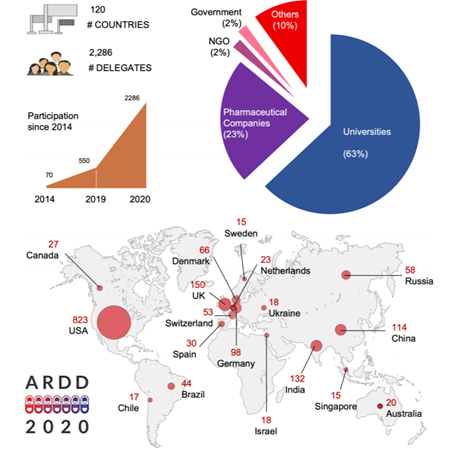The proportion of aged people in the global population continues to rise, posing a number of health-related issues for societies relating to age-associated conditions. To attenuate these challenges, increasing research aimed at healthy aging and improved lifespan has revealed insight into longevity-related biological mechanisms that can be used to develop therapeutics to combat aging.
The Aging Research and Drug Discovery (ARDD) Online Meeting On Aging Genetics and Therapeutics
From September 1st to September 4th, 2020, a meeting was held between Scheibye-Knudsen and colleagues from various global universities, and the report from that meeting was published in the journal Aging. The report predominantly addresses primary research on age-associated molecular mechanisms and current aging treatments. In addition, the report discusses novel methods for aging research such as genetically-based aging clocks and evaluation of alterations to DNA such as mutations that accumulate over time. This group of researchers shares fresh results on lifestyle adjustments and pharmacological therapies for healthspan and lifespan management to halt or reverse these genetic changes, thereby diminishing aging.

Using AI to Analyze DNA and Predict Biological Age
During the meeting, investigators discussed advancements in methods for analyzing people’s DNA for aging studies. In particular, progress in artificial intelligence (AI) research has allowed scientists to forecast chronological age and biological age successfully. Chronological age refers to one’s age in years, and biological age refers to one’s physiological age. Moreover, from the University of California Los Angeles, Dr. Steve Horvath developed a biological aging clock that measures molecular markers on DNA called methylation to determine chronological age and the risk of death. Future research that investigates DNA methylations in relation to biological aging shows promise in predicting biological age and determining the efficacy of safe therapeutics that slow or reverse the progression of biological age.
DNA Sequence Changes May Facilitate Aging
Investigators have identified other DNA modifications that accumulate over time, such as point mutations and genomic rearrangements. From the Albert Einstein College of Medicine, Jan Vijg introduced findings on these mutations and discussed their connection to disease, mortality, and death occurrence. By conducting genetic sequencing on human white blood cells called B lymphocytes, she successfully showed that mutation frequency exponentially increases upon aging. Based on this evidence, Dr. Vijg hypothesized that de novo, or new, mutations are acquired from initial developmental stages all the way to adulthood and old age.
Chromosome Alterations May Affect Fertility
Dr. Eva Hoffman of the University of Copenhagen in Denmark also gave a talk about her investigations on the reproductive lifespan. Hoffman’s research suggests that errors in chromosomes and irregularities in egg cells, oocytes, which control natural fertility in humans, cause changes in fertility rates as people age. This understanding of reproductive aging is paving the road for developing therapeutics to target infertility.
Reducing Specific Dietary Protein Building Blocks May Improve Metabolic Health and Delay Aging
Dietary approaches for metabolic intervention serve as one alternative therapeutic to delay the accumulation of DNA methylation markers and mutations that promote aging. Research presented by Dr. Dudley Lamming of the University of Wisconsin focused on the importance of crucial dietary amino acids—structural units that build up proteins—in regulating lifespan. In the Lamming laboratory, investigators demonstrated that mice could achieve improved metabolic health and reduced body fat content (adiposity) by diminishing certain amino acids called branched-chain amino acids (valine, leucine, and isoleucine). In addition, they found that lowering the levels of these amino acids also increased lifespan in progeroid mice, which are experimental rodent models of aging that exhibit characteristics of the human disease progeria, which causes people to appear older than their actual age. If these presented findings are applicable to humans, eliminating specific amino acids from our diets, such as valine, leucine, and isoleucine, could enhance metabolic health and possibly lengthen lifespan.
Enzyme Inhibitors May Enhance Healthy Aging
Research presented by Dr. Eric Verdin of the Buck Institute focused on the development of pharmacological applications that utilize nicotinamide adenine dinucleotide (NAD+), a vital coenzyme for metabolism and sustaining cellular health. Furthermore, this research heavily revolved around the enzyme called CD38, known to deplete NAD+ and increase in concentration upon aging. Thus, Finding a method to effectively reduce NAD+ consumption by blocking CD38 could lead to new approaches that optimize metabolism, allowing for healthier aging and improved lifespan.
The Future Looks Bright for Aging Research
“Conserved molecular pathways underlining aging can be manipulated using genetic, pharmacological and non-pharmacological approaches to significantly improve healthspan and lifespan in model organisms, and perhaps humans,” stated Scheibye-Knudsen and colleagues in their meeting report. Notably, the collaboration between biotechnology companies and academia continues to progress with hopes of accelerating the discovery of novel therapeutics to combat aging. According to Scheibye-Knudsen and colleagues, there is a lot of promise in future aging research.